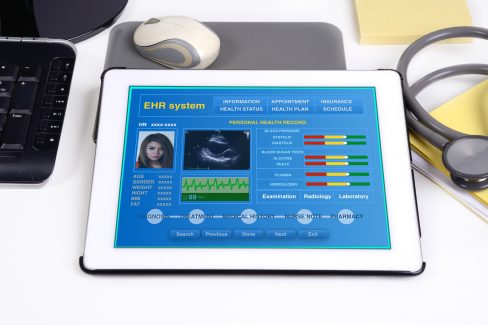August 10, 2023
Technology has long been a driving force in the healthcare industry, but never more than it is today. In fact, a 2022 Accenture survey found that “97 percent of healthcare executives believe continuous advances in technology are becoming more reliable than economic, political or social trends in informing their organization’s long-term strategy.”
Cloud adoption is a major factor, reflected by a global healthcare cloud computing market that’s projected to grow by more than $42 billion through 2027 with a CAGR of 20.55 percent. Thirty-nine percent of that growth is estimated to come from North America (the U.S., Canada and Mexico). According to Gartner, overall cloud spend in 2023 alone will hit $600 billion.
“The overall trend is not limited to healthcare,” Medcitynews.com explained, “but its impact in the sector means that deep-seated intransigence on adopting new technologies is becoming viewed as an existential threat. Throwing dollars at increasingly archaic legacy architecture is now dangerously wasteful.”
The publication went on to cite the remarks of a Florida hospital CIO, who recently told Becker’s, “We don’t view cloud service as a ‘nice to have’ or unnecessary expense, because the cost is still there whether it is a cloud service or pricey asset renewal of on-premise computer equipment. We are making seismic transitions away from on-premise equipment to cloud environments to lower our risk profile with better resiliency and availability.”
That Florida CIO is in very good company. Fast Company quoted several hospital executives who have fully and enthusiastically embraced the cloud. One of them, Mayo Clinic CFO Dennis Dahlen, explained that, “Patients come to us for answers and treatments they can’t get anywhere else. To enable our teams to focus on patients while transforming the way healthcare is delivered, it’s critical to have the right administrative infrastructure to support our business.” Which is why the organization, as the magazine summarized, “recently deployed the Oracle Fusion Cloud Applications suite to manage finance, HR, and supply-chain processes on a single integrated platform.” Another tech exec at Northwell Health said her organization “needed a better way to calculate staffing needs and manage our search for staff so we could maximize patient safety.” They accomplished that with the help of Oracle Fusion Cloud Applications, Oracle Analytics Cloud and Oracle Autonomous Data Warehouse.

Given the vast amounts of data in healthcare organizations and the need to verify and validate identity to deliver the right care to the right people, cybersecurity protocols continue to be top of mind. Or at least they should be. The organizations that aren’t taking cybersecurity seriously may well be in for a rude awakening. “Health care organizations are particularly vulnerable and targeted by cyberattacks because they possess so much information of high monetary and intelligence value to cyber thieves and nation-state actors,” the American Hospital Association warns. “The targeted data includes patients’ protected health information (PHI), financial information like credit card and bank account numbers, personally identifiable information (PII) such as Social Security numbers, and intellectual property related to medical research and innovation.”
The solution, which is far from a cure to this ever-expanding plague, is to make cybersecurity a priority — and not just in theory. Hire more IT staff to monitor operations. Spend more money on the latest tech. Above all, the article notes, “instill a patient safety-focused culture of cybersecurity. This enables health care organizations to leverage their existing culture of patient care to impart a complementary culture of cybersecurity. A culture of cybersecurity, where the staff members view themselves as proactive defenders of patients and their data, will have a tremendous impact in mitigating cyber risk to the organization and to patients.”
Of course, cloud and cybersecurity aren’t the only major tech trends on the healthcare front (though the former is often a facilitating factor). Writing in Forbes earlier this year, Audacity Health CEO and chief strategy officer Jill Collins noted the “incredible momentum in areas such as multi-omics and molecular diagnostics, personalized care and digital health solutions that will play an increasingly important role in the future of healthcare delivery. The industry is already taking steps to maximize the potential of advanced technologies, from AI-enabled solutions to digital ecosystems.”

She also detailed five tech trends that, in her informed opinion, will continue to transform the sector. Here are the trends, along with brief excerpts of her full remarks. (Read the full article here.)
- Multi-Omic Technologies Are Fueling the Next Precision Medicine Wave
“These omics solutions offer a more nuanced understanding of human health by providing insights into the molecular changes or characteristics that can impact health, cause disease or guide clinical decisions.”
- Digital Health Solutions Will Continue To Evolve
“[T]here is still strong momentum in digital health that’s driving the adoption of new solutions. Many technologies will likely focus on expanding access to care via an integrated experience and on generating data that can improve patient and population health.
- Improving Access To Health Data Will Enhance Personalized Care
“[T]here will be a need for solutions that tackle the data access challenge by improving platform interoperability through centralized data hubs…Centralizing this data will support not only personalized medicine but also the shift toward value-based care models by enabling accurate risk adjustment and quality evaluation methods while enhancing benchmarking and patient attribution methods.”
- Artificial Intelligence Will Continue To Transform Healthcare
“In 2023, I think we will likely see a significant increase in the application of AI in testing and drug development and tools that enable personalized care.
- Businesses Will Continue Streamlining Operations For Increased Efficiency
The cost-cutting trend of reducing staff and restructuring “is likely to continue in the coming year as organizations look to conserve cash flow while creating a leaner organizational structure.” There also will be “investments in digital solutions that improve clinical and lab workflows and simplify patient care coordination and delivery.
About Mindsight
Mindsight is industry recognized for delivering secure IT solutions and thought leadership that address your infrastructure and communications needs. Our engineers are expert level only – and they’re known as the most respected and valued engineering team based in Chicago, serving emerging to enterprise organizations around the globe. That’s why clients trust Mindsight as an extension of their IT team.
Visit us at http://www.gomindsight.com.
